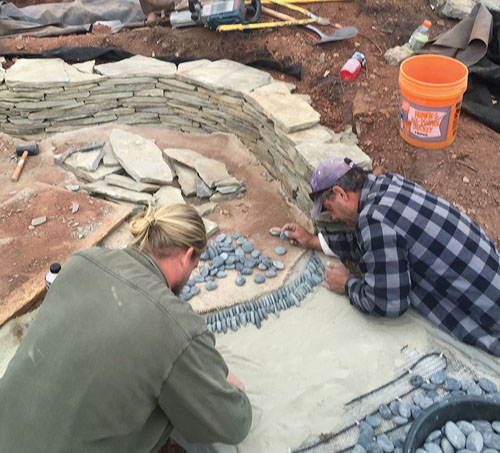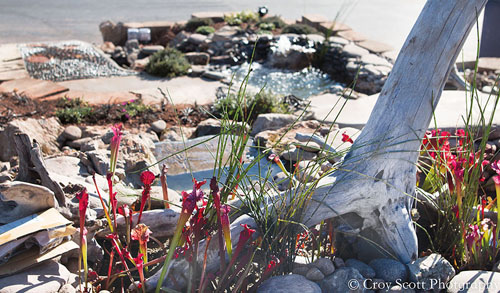
Over the years, repeat customers — those with whom we’ve built a lasting relationship based on our shared passion for ponds and water features — have become one of our main sources of business. One shining example of a repeat customer is our good friend and customer, Mary Lou. We met Mary Lou a few years ago when Brian Fitzsimmons, the owner of Fitz’s Fish Ponds, offered to deliver some koi she had purchased from our old retail store.
Mary Lou had trouble getting around unassisted and often used a wheelchair if she had to walk more than a few steps. Enjoying her pond was one of her favorite things to do, but she was starting to have some trouble maintaining it. We offered to begin servicing her pond on a regular basis, and the relationship grew from there.
The Storr-y Begins
We embarked on our first construction project with Mary Lou when we learned — quite surprisingly – that she was the owner of Storr Tractor Company, a multi-million-dollar landscape supply company. We knew Mary Lou spent a lot of time there, so we thought we would present her with a unique project for her company’s headquarters, integrating her love of water features and the company’s focus on the water feature business.To begin, Mike Hall, our construction manager and designer, visited the Storr Tractor site to hold a design meeting, ask a series of design-related questions and schedule a site visit. Just as he does with all his jobs, he took a look at all the factors that could potentially affect the build and final project, including sun exposure, water sources, microclimates, animal traffic, people traffic and drainage issues.
Avoiding a Traffic Jam
With this particular site, we had to deal with a full sun, southern exposure and an issue with pedestrian traffic. The build site separated an upper parking lot with a lower parking lot. Customers could see the entrance to the building, but in order to reach it, they would have to walk all the way around the construction site, which previously was an old garden bed with a small, pondless stream. Storr Tractor was a business with high foot traffic, so this was our biggest concern.


[box] Only the long, skinny pebbles would set in the concrete properly, so everything else had to be discarded ahead of time, left. By varying the stone color and direction, we created a wavy, spiral pattern —essentially organized chaos, right.[/box]
The solution we came up with involved a sidewalk with a set of bridges meandering down to the lower parking lot with a one-of-a-kind, pebble mosaic bridge. The entire pathway would be heated with embedded cables to keep it free of ice in the winter and prevent damage from snow removal. This would allow customers and employees to cut through the parking lot safely and still enjoy the water feature. The pebble mosaic bridge would make the pathway the centerpiece of the water feature rather than a boring cement pathway cutting through the middle of the site.
A Customized Centerpiece
As mentioned previously, Storr Tractor sells landscape equipment, including commercial tractors. In order to tie in the theme of the business with the water feature, a series of custom, carved, blue stone tractor-tire treads would be set in the sidewalk cement. We also planned to carve the company’s logo into the pathway and stain it green to further customize the feature for the Storr Tractor Company.

We suggested planting a peat bog and carnivorous pitcher plants at the start of the site. There was just enough shade on the north side under an existing birch tree to grow the peat. The stream split at that point and went toward the outside of the site on both sides. After traveling down several spillways and turns, the two streams met again at the bottom and disappeared under the rocks. The heated cement sidewalk would go down the middle and cross the stream twice with cement bridges, the pebble mosaic bridge being the lower of the two. Several bubbling rocks would be placed in the stream with one unique rock placed as a spillway. Retaining walls would add height and create planting areas.
After drawing up the design and holding a final meeting with Mary Lou, we were given the go-ahead to start. We could tell that Mary Lou was just as excited as we were to see this idea come to life, and we certainly did not want to disappoint her.
A Bridge to Everywhere
The construction started with the demolition of the existing pondless stream and the removal of all the vegetation, with the exception of a multi-stemmed paper birch. Next, we sprayed and marked everything. The sidewalk and bridges went in first. The code in New Jersey requires a depth of 36 inches for footings, so we used four 36-inch-deep Sonotubes for each bridge.

The concrete for the bridges and rest of the sidewalk had to be set in layers. First, we created the forms and poured a 4-inch base. Next, all the heating elements and sensors were installed. After that, two more inches were poured, and the tractor tire treads were set in the entire sidewalk, with the exception of the mosaic bridge. The mosaic bridge was set in dry mortar. All the pebbles were set on their edges, with two-thirds in the dry mortar and one-third exposed. We spent around 40 hours sorting pebbles for the correct profiles.
After the mosaic was set, which took two days, a final layer of dried mortar was applied and brushed down to the finished profile. We used a backpack sprayer with water to mist and soak all the mortar without any pooling. The piece was covered and misted again for a month’s time to avoid any cracking. This was one of the biggest pebble mosaics we had ever created, and the result was a unique and beautiful centerpiece for the feature.
Rockin’ the Stream
For the water feature, we were looking for more of a fantasy-land design than a natural look. We stacked hand-sorted, flat, river stone between moss boulders. Core-drilled, bubbling moss boulders were also placed throughout the stream bed. One moss boulder had a natural hole that just was begging us to flow water through it, so that was also incorporated. An underground basin at the bottom of the falls collected water that would be recycled to the top. Some dry-stacked, flat walls were used to create plant beds, and the whole project was planted with both aquatic and terrestrial plants.

The entire build took approximately a month to complete, and Mary Lou was thrilled with the result. She now could enjoy the serenity of a water feature both at home and at work. Thanks to the success of this project, she hired us to do a complete makeover in her backyard, including a 18,000-gallon koi pond! That’s a story for another day, however.
We learned from this experience that customer relationships are extremely important, and maintaining those relationships over the years is beneficial to all parties involved. I’m sure you’ll agree with us when we say we wish everyone loved water features as much as Mary Lou does!


